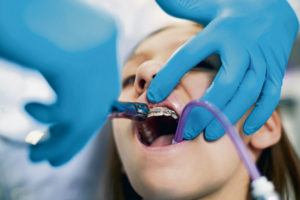 For children, everything around them is in constant motion. Among these things are their teeth. A common misconception many people take after is the effectiveness of braces after youth. The fact of the matter is applying braces well into your adult years can cause more harm than damage.
For children, everything around them is in constant motion. Among these things are their teeth. A common misconception many people take after is the effectiveness of braces after youth. The fact of the matter is applying braces well into your adult years can cause more harm than damage.
In young mouths, the teeth are still moving and have not established their permanent roots. This allows for easier placement and manipulation of said teeth. This also allows for better results after the braces are removed. Anyone who cycles through their time of wearing braces are highly encouraged to wear their retainer to keep the teeth in position, but for children, this is much more of a subject due to the more frequent movement of their teeth.
The early preteen years, somewhere between the ages of ten to fourteen, are the most ideal years to attach braces. The jawbone is much softer between these ages, allowing for easier movement and adjustments. Although this time period may be ideal, some patients may have to wait until their adult teeth grow in before getting their braces. If the braces are applied prior to having all of the adult teeth grown in, the patient may suffer from over-crowded teeth and may have to be subject to wearing braces for a second time.
Usually, after these years, the jawbone hardens and the teeth move into their more cemented positions. This complicates the process of doing any more work on them after placement. The teeth may fall out because of the “uprooting” of the teeth that tends to happen when braces are applied into adult years. Uprooting can unfortunately promote the unhealthy eruption of these adult teeth, which are not commonly known to grow back. It is important to take all necessary measures to protect adult teeth.
When you think about braces, you commonly think about the traditional wire and brackets that are cemented onto your teeth. Within the past decade, you can see patients opt into wearing an invisible type of braces more often. These new types of braces are sets of personalized trays that gradually shift the patients bite into alignment. The purpose of these braces allows the patient to have more of an esthetic look compared to a mouth full of metal. Although these braces look better, this puts a lot of responsibility onto the patient as they are in charge of actually cleaning and proper wearing.
Contrary to popular belief, more dental professionals recommend the use of personalized retainers as opposed to the widely advertised “one size fits all” retainers. The latter fail to provide any real retention for the teeth and are much less effective in providing the service it is meant to provide. The purpose of a retainer is to keep the teeth in the desired position that the braces shifted them into. This puts a little extra emphasis on the type and quality of the retainer a patient should decide to wear.
For the most part, your overall health begins in the mouth. The way a person cares for their dental health plays a large part in the operations and effectiveness of the other systems of the body. Your body works for you. Treat it back.







